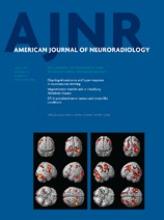Research ArticleBrain
Open Access
Prediction of Aphasia Outcome Using Diffusion Tensor Tractography for Arcuate Fasciculus in Stroke
S.H. Kim and S.H. Jang
American Journal of Neuroradiology April 2013, 34 (4) 785-790; DOI: https://doi.org/10.3174/ajnr.A3259
S.H. Kim
aFrom the Department of Physical Medicine and Rehabilitation, College of Medicine, Yeungnam University, Taegu, Republic of Korea.
S.H. Jang
aFrom the Department of Physical Medicine and Rehabilitation, College of Medicine, Yeungnam University, Taegu, Republic of Korea.

References
- 1.↵
- Engelter ST,
- Gostynski M,
- Papa S,
- et al
- 2.↵
- Wade DT,
- Hewer RL,
- David RM,
- et al
- 3.↵
- Kauhanen ML,
- Korpelainen JT,
- Hiltunen P,
- et al
- 4.↵
- Robey RR
- 5.↵
- Berthier ML
- 6.↵
- Payabvash S,
- Kamalian S,
- Fung S,
- et al
- 7.↵
- Thulborn KR,
- Carpenter PA,
- Just MA
- 8.↵
- Marchina S,
- Zhu LL,
- Norton A,
- et al
- 9.↵
- Assaf Y,
- Pasternak O
- 10.↵
- Mori S,
- Crain BJ,
- Chacko VP,
- et al
- 11.↵
- Jang SH
- 12.↵
- Puig J,
- Pedraza S,
- Blasco G,
- et al
- 13.↵
- 14.↵
- Hosomi A,
- Nagakane Y,
- Yamada K,
- et al
- 15.↵
- Schlaug G,
- Marchina S,
- Norton A
- 16.↵
- Breier JI,
- Hasan KM,
- Zhang W,
- et al
- 17.↵
- Kim H,
- Na DL
- 18.↵
- 19.↵
- Demeurisse G,
- Demol O,
- Derouck M,
- et al
- 20.↵
- Sarno MT,
- Levita E
- 21.↵
- Pedersen PM,
- Jørgensen HS,
- Nakayama H,
- et al
- 22.↵
- Hartman J
- 23.↵
- Shewan CM,
- Kertesz A
- 24.↵
- Smith SM,
- Jenkinson M,
- Woolrich MW,
- et al
- 25.↵
- Jiang H,
- van Zijl PC,
- Kim J,
- et al
- 26.↵
- Nucifora PG,
- Verma R,
- Melhem ER,
- et al
- 27.↵
- Vernooij MW,
- Smits M,
- Wielopolski PA,
- et al
- 28.↵
- 29.↵
- Catani M,
- Mesulam M
- 30.↵
- Bernal B,
- Ardila A
- 31.↵
- Shuren JE,
- Schefft BK,
- Yeh HS,
- et al
- 32.↵
- Kim SH,
- Hong JH,
- You H,
- et al
- 33.↵
- Kertesz A,
- Harlock W,
- Coates R
- 34.↵
- Marshall RC,
- Phillips DS
- 35.↵
- Laska AC,
- Hellblom A,
- Murray V,
- et al
- 36.↵
- Fernandez B,
- Cardebat D,
- Demonet JF,
- et al
- 37.↵
- 38.↵
- Saur D,
- Lange R,
- Baumgaertner A,
- et al
- 39.↵
- Kertesz A,
- McCabe P
- 40.↵
- 41.↵
- Rauschecker AM,
- Deutsch GK,
- Ben-Shachar M,
- et al
- 42.↵
- Yang Q,
- Tress BM,
- Barber PA,
- et al
- 43.↵
- 44.↵
- Parker GJ,
- Alexander DC
- 45.↵
- Huang H,
- Zhang J,
- van Zijl PC,
- et al
In this issue
Advertisement
S.H. Kim, S.H. Jang
Prediction of Aphasia Outcome Using Diffusion Tensor Tractography for Arcuate Fasciculus in Stroke
American Journal of Neuroradiology Apr 2013, 34 (4) 785-790; DOI: 10.3174/ajnr.A3259
0 Responses
Jump to section
Related Articles
- No related articles found.
Cited By...
- Simulated Attack Reveals How Lesions Affect Network Properties in Poststroke Aphasia
- Simulated attack reveals how lesions affect network properties in post-stroke aphasia
- MRI Tractography of Corticospinal Tract and Arcuate Fasciculus in High-Grade Gliomas Performed by Constrained Spherical Deconvolution: Qualitative and Quantitative Analysis
- The Importance of Premotor Cortex for Supporting Speech Production after Left Capsular-Putaminal Damage
This article has not yet been cited by articles in journals that are participating in Crossref Cited-by Linking.
More in this TOC Section
Similar Articles
Advertisement











